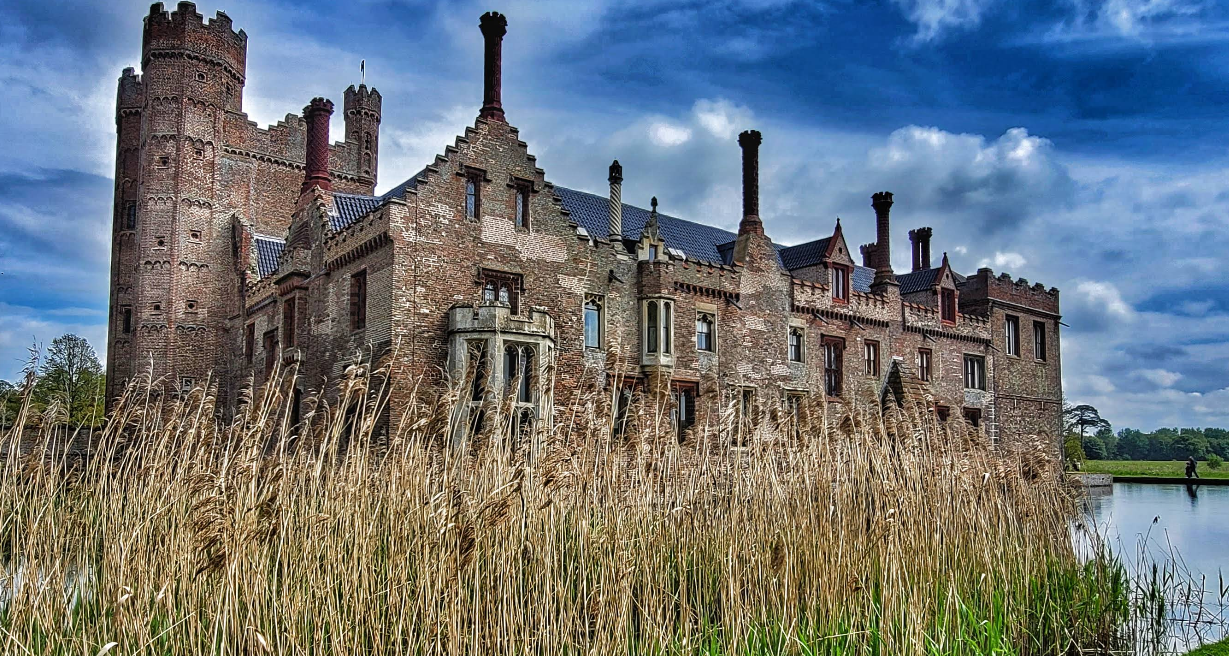Oxborough, Norfolk
This page needs more content
Minutes drive from Belchamp Walter. 1hr 17min Sunday 11:20
Wimpole Estate
Oxborough, Norfolk
Oxburgh House is a moated country house near near Swaffham, Norfolk
The history of Oxburgh House revolves around the Bedingfeld family. The NT page on the estate says:
Built by the Bedingfeld family in 1482 as a statement of power, Oxburgh and the family have endured turbulent
times. Through religious persecution, Civil War devastation,
near dereliction and threatened demolition, Oxburgh’s story is one of survival.
Sir Edmund Bedingfeld, 1482, was a catholic who was a contemporary of Edward IV,
1461-1470 and 1471-1483. The hall was built at the end of Edward's reign and end of the Wars of the Roses.
The Wars of the Roses were fought 1455 to 1487. This would suggest that Bedingfeld was a Yorkist.
The Bedingfeld, later Paston-Bedingfeld family
The Wikipedia page said: (about the Baronetcy)
The Bedingfeld, later Paston-Bedingfeld Baronetcy, of Oxburgh in the County of Norfolk, is a title
in the Baronetage of England.
It was created by Charles II of England in recompense for the family's losses in the Royalist cause
during the Civil War and Interregnum years.[1]
The Bedingfelds are said to descend from 'Ogerlis', a Norman, who, in 1100, held land at
Bedingfield, Suffolk. His descendant, Edmund Bedingfeld, married Margaret (died 1446),
daughter and heiress of Sir Robert Tuddenham (and sister and co-heir of her brother
Sir Thomas Tuddenham, executed in 1462),
bringing to her husband estates including the manor of Oxburgh, near Swaffham, Norfolk.
Top
The Bedingfelds and the Tudors.
The Bedingfeld family at Oxburgh Hall were rising stars of the royal court in Tudor times,
but when Sir Henry Bedingfeld refused to sign the Act of Uniformity in 1559
it meant the devout
Catholic family were ostracised and persecuted - leading to the famous secret priest hole at Oxburgh Hall,
which was constructed to help shelter Catholic clergy.
Oxburgh Hall
Oxburgh Hall is a moated country house in Oxborough, Norfolk, England. The hall was built for
Sir Edmund Bedingfeld who obtained a licence to crenellate in 1482.
The Bedingfelds gained the manor of Oxborough through marriage in the early 15th century,
and the family has lived at the hall since its construction, although ownership passed to
the National Trust in 1952. The house underwent extensive refurbishment
in the mid 19th century under John Chessell Buckler and Augustus Pugin.
Act of Uniformity in 1559
The Act of Uniformity 1558 (1 Eliz. 1. c. 2) was an act of the Parliament of England, passed in 1559,[d]
to regularise prayer, divine worship and the administration of the sacraments in the Church of England.
In so doing, it mandated worship according to the attached 1559
Book of Common Prayer.
The act was part of the Elizabethan Religious Settlement in England instituted by
Elizabeth I,
who wanted to unify the church. Other acts concerned with this settlement were the
Act of Supremacy 1558 (1 Eliz. 1. c. 1) and the Thirty-Nine Articles.
Left handed spriral staircase.
Paston and de Vere
In my expansion of my study of the de Vere family a connection to de Vere and
the Paston family came to light. This was prompted by a visit to Oxburgh Hall in Norfolk.
Sir John Paston (1444 – 28 August 1504), was the second son of John Paston and Margaret Mautby.
He succeeded his elder brother, Sir John Paston, in 1479. He fought at Barnet and Stoke with
John de Vere, 13th Earl of Oxford, served as his deputy when Oxford was appointed Lord High Admiral of England,
and was a member of the Earl's council. A number of his letters survive among the Paston Letters, a rich source of
historical information about the lives of the English gentry of the period.
WikiTree:
John Paston, born in 1444, probably at Geldeston, Norfolk, was the second son of John Paston and Margaret Mautby,
daughter and heir of John Mautby of Mautby, Norfolk.[1] He had an elder brother, also named John, as well as three younger
brothers, Edmund, Walter and William, and two sisters, Margery and Anne.
Assumption of the Paston name
This is not made clear on the National Trust website or at Oxburgh House. However, Paston features in relation
to John de Vere, 13th Earl of Oxford and took me to investigating the Paston Letters.
The sixth Baronet married Margaret Anne, daughter and heiress of Edward Paston.
In 1830 he assumed by Royal licence the additional surname of Paston.
The eighth Baronet was a Major in the 3rd Battalion of the Liverpool Regiment, and served in the Second Boer War.
The present Baronet is a co-heir to the ancient barony of Grandison, which has been in abeyance since 1375.
Henry Paston-Bedingfeld, the noted officer of arms, is the 10th baronet.
The Paston Letters are recorded to have been written at the de Vere House in Lavenham.
Mary Queen of Scots and Bess of Hardwick
In addition to the support for Mary I the Paston-Bedingfields possibly have a connection to Mary Queen of Scots. There are some tapestries on display on the first floor of the Hall.
The Oxburgh Hangings (1st floor)
The Oxburgh Hangings, on loan to the National Trust by the Victoria & Albert Museum, comprise of multiple embroidered panels set against a background of green velvet, forming three large hangings. They were created by Mary, Queen of Scots and Bess of Hardwick between 1569 and 1584, when Mary was in captivity on the orders of Elizabeth I. They came to Oxburgh through a marriage in 1761. Here you can admire the animal and floral designs of these rare and exquisite panels and explore the symbolism lurking beneath apparently innocent images.
Mary Queen of Scots was kept captive in many English castles and manor houses, particularly those owned by Elizabeth Shrewsbury (Bess of Hardwick). It is not clear if Oxburgh was one of the houses that she was encaserated before she was beheaded at Fotheringay Castle in 1587.
